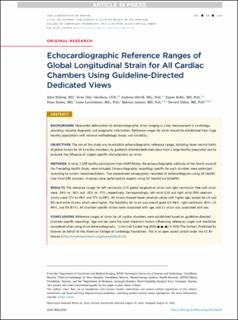| dc.description.abstract | Background
Myocardial deformation by echocardiographic strain imaging is a key measurement in cardiology, providing valuable diagnostic and prognostic information. Reference ranges for strain should be established from large healthy populations with minimal methodologic biases and variability.
Objectives
The aim of this study was to establish echocardiographic reference ranges, including lower normal limits of global strains for all 4 cardiac chambers, by guideline-directed dedicated views from a large healthy population and to evaluate the influence of subject-specific characteristics on strain.
Methods
In total, 1,329 healthy participants from HUNT4Echo, the echocardiographic substudy of the fourth wave of the Trøndelag Health Study, were included. Echocardiographic recordings specific for each chamber were optimized according to current recommendations. Two experienced sonographers recorded all echocardiograms using GE HealthCare Vivid E95 scanners. Analyses were performed by experts using GE HealthCare EchoPAC.
Results
The reference ranges for left ventricular (LV) global longitudinal strain and right ventricular free-wall strain were –24% to –16% and –35% to –17%, respectively. Correspondingly, left atrial (LA) and right atrial (RA) reservoir strains were 17% to 49% and 17% to 59%. All strains showed lower absolute values with higher age, except for LA and RA contractile strains, which were higher. The feasibility for strain was overall good (LV 96%, right ventricular 83%, LA 94%, and RA 87%). All chamber-specific strains were associated with age, and LV strain was associated with sex.
Conclusions
Reference ranges of strain for all cardiac chambers were established based on guideline-directed chamber-specific recordings. Age and sex were the most important factors influencing reference ranges and should be considered when using strain echocardiography. | en_US |

